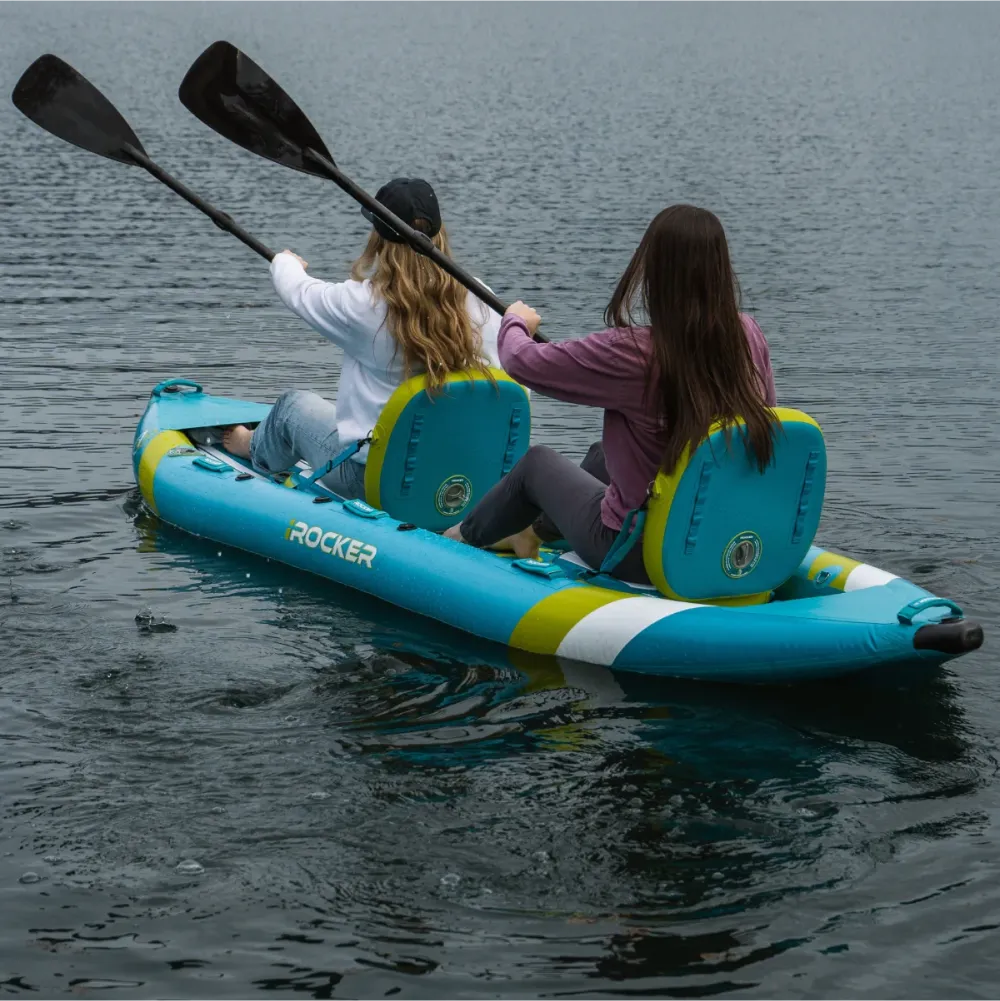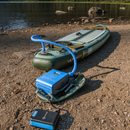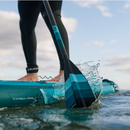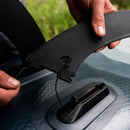Is Kayaking Good Exercise? All Health Benefits You Need to Know

Many paddlers often wonder, ‘is kayaking good exercise?’. Yes. Kayaking, just like any other sport, offers a wide range of health benefits.
You’d be surprised to learn that paddling through the water does not only improve your physical health but your mental well-being as well.
Whether you’re new to the amazing world of kayaking or a veteran on the boat, kayaking is one of the best ways to stay active, healthy and have fun.
Does Kayaking Build Muscles?
Kayaking does build muscles. However, kayaking is not weightlifting. While it does help muscles grow and reduce fat to an extent, it’s not going to magically give you a six pack or a super shredded body.

That being said, kayaking is still an excellent form of exercise. The twisting movement that is required to paddle works muscles in your core, back, arms, shoulders, and legs.
It’s what makes paddling on a kayak good exercise for the muscles because it helps to increase endurance and tone them over time.
When you maneuver the paddle to work against the stream, you’re using the muscles in your arms and shoulders. To balance and brace yourself, you need to engage your core and legs, giving a good lower body muscle group workout.
What muscles does kayaking work on?
So, now you know the answer to ‘Is kayaking a good exercise for building muscles? Let’s break down specifically how each muscle group benefits from this fantastic form of sport.
Upper Body Muscles
The force of water is strong, but it’s what makes being on a kayak good exercise for muscle growth. You will need to actively engage upper body muscles to move against it.
1. Lats
Your lats (latissimus dorsi), the largest muscles in your back, are really put to good work as you paddle. They contract to pull the paddle through the water, propelling you forward. As you maintain stability, the muscles are responsible for keeping your posture upright.
2. Biceps
The biceps work in conjunction with the lats as you pull your arms back and bend your elbows. When performed correctly, these movements can activate the biceps. At the same time, the process of setting up and getting in and out of the kayak also requires you to engage your biceps for better balance.
3. Forearms
The forearms are the key to kayaking correctly as the movements provide grip strength. If you activate a muscle continuously without rest time, it can be counterproductive. Since kayaking requires the harmony of contracting and releasing muscles, your forearms can get toned and develop better resistance to exhaustion.
4. Shoulder
The deltoids and rotator cuff muscles are heavily involved in kayaking. Paddling would not be possible if it were not for the range of motion these muscles provide. Together with the lats and back, the shoulder muscles generate power for most kayaking techniques. Overtime training will strengthen the shoulders and add bulk to them.
- Back
You can’t kayak well with just the use of your arms or shoulders. Your back muscles, particularly the trapezius, rhomboids, and erector spinae, are equally crucial. In fact, the use of other muscles helps strengthen your back, and your back being in the proper position is what keeps other muscles working together effectively.
Lower Body Muscles
If your upper body muscles are given a good workout by generating power for propulsion, your lower body muscles are refined by providing stability and balance while paddling.
1. Core
The core muscles include the abdominals, lower back, and obliques. When engaged, they help stabilize the body. These muscles also assist in rotation and power transfer during the paddling stroke. Kayaking techniques will naturally require your core to engage in order to perform them right.
To properly engage your core while kayaking, pay attention to your breathing and how tight and secure your position feels. You will feel a sense of resistance in your muscles.
2. Legs
You might think that sitting on the kayak won’t give your leg muscles the exercise they need to bulk up. However, the quadriceps, hamstrings, and calves work together to provide a strong base for other actions. You will find that your legs push against the foot pegs or bulkhead for each stroke.
If you prefer an extra boost lower body workout, some kayak types come with pedals.
Is kayaking good cardio?
Not only is kayaking a good workout for your upper and lower body muscles, but it can also be your cardiovascular system’s new fitness best friend. Why is that?

Kayaking can be considered an aerobic exercise (Michael J.S., Rooney K.B., and Smith R., 2008). This is because kayaking involves continuous paddling, making your heart beat faster. The increased heart rate helps with the flow of blood, thus improving circulation.
When your heart beats faster, calories are burned. Thirty minutes of leisure kayaking burns around 180 calories for a person weighing 155 pounds (Hardvard Health, 2021).
As you conquer more challenging waters and paddle more distance, more calories are burned. Depending on your weight loss goal, you can adjust your kayaking route and time as you see fit.
Combined with the use of a variety of muscle groups, kayaking is a very good choice for cardio exercise.
Additional Kayaking Health Benefits
Apart from the physical benefits, many people also believe being on a kayak is good exercise for their mental wellbeing. It’s true.
Here are more wonderful benefits of kayaking.
Stress Relief
Think of the fresh air, the breathtaking scenery and the energy exhaustion your body craves after being stuck at home all week. This perfect mix of physical and mental activity releases endorphins - a hormone that makes you feel good.
So, next time you feel a bit down or overwhelmed, grab your kayak, get out on the water and paddle your stress away.
Improved Focus
To kayak, you need to train your body to coordinate well. The water isn’t always free of obstacles. You will also have to train yourself to think quickly to navigate the rocks, the currents and the changing water conditions. This requires your brain to concentrate, which can be a good meal your brain needs to keep it sharp.
Enhanced Endurance
Is kayaking good exercise to better your endurance? Absolutely.
Kayaking increases heart rate, thus strengthening your heart muscles. To cover the desired distance, you need to use your strength correctly and control your breathing to avoid getting tired halfway, which can improve the capacity of your lungs.

All of these benefits can contribute to your ability to paddle in more intense conditions and cover further distances. Kayak frequently enough and you will find that other similar sports also become easier to master.
Meditative
It’s not always about rocky water and cut-throat currents. When you go kayaking in calmer water, you may find that the evenly paced paddling motion brings a sense of peace. With nature as your backdrop, you will be pulled into a tranquil trance and feel more rejuvenated.
So, Is Kayaking Good Exercise for Overall Health?
Absolutely. There are so many amazing answers to ‘Why is kayaking good exercise?’ You’d be surprised to learn that both the body and the mind can benefit from this amazing sport.
Your upper body muscles, including your arms, back and shoulders, are put to good work as they are the key to paddling and steering the kayak.
To keep your upper body muscles working properly and provide stability, your core strength and legs are also called into action.
In addition, kayaking can also reduce stress and improve concentration and endurance.

Ready to achieve your fitness goal with a kayak? Doing it with an inflatable kayak is even better.
Inflatable kayaks are extremely easy to transport and store, making them as compact as any other workout equipment.
Versatility is also one of an inflatable kayak’s strong suits. Serene lakes, flowing rivers, or wavy beaches - you name it, inflatable kayaks are up for the adventures. It makes exercising with a kayak an even more enjoyable sport.
Ready to elevate your kayaking experience? The iROCKER Inflatable Kayak is designed for stability, durability, and ease of use. Made from high-quality materials, it offers reliable performance and is easy to transport and store. Perfect for both beginners and experienced kayakers, it features comfortable seating and ample storage.
FAQ
Still curious is kayaking good exercise for you? These answers may satisfy your questions.
Is kayaking a good workout for weight loss?
Yes, kayaking is a good exercise for weight loss and body toning. According to Harvard Health, 30 minutes of kayaking (both recreational and whitewater) burns 180 calories, just 36 calories fewer than other sports such as jogging, hiking and wrestling. If you paddle harder or further, you can burn even more calories.
Is kayaking a challenging workout?
Not really, kayaking techniques are quite simple, and the workout comes naturally as you paddle. It provides good exercise for the arms, shoulders, back, legs, and core muscles.
Recreational kayaking focuses on calm and relaxed paddling to enjoy the outdoors rather than pushing the body to the limits. Whitewater kayaking may take some time and effort to be done right, but if you master the basics and have the right equipment, it’s not going to be much of a challenge.
Sources:
Michael J.S., Rooney K.B., & Smith R. (2008). The metabolic demands of kayaking: a review. J Sports Sci Med, 7(1), 1-7. https://www.ncbi.nlm.nih.gov/pmc/articles/PMC3763332/
Harvard Health Publishing. (2021, March). Calories burned in 30 minutes for people of three different weights. Harvard Health. https://www.health.harvard.edu/diet-and-weight-loss/calories-burned-in-30-minutes-for-people-of-three-different-weights






